16
Diseases of the External Auditory Canal
Chad A. Zender, Sam J. Marzo, and John P. Leonetti
The external auditory canal (EAC) is a bony and cartilaginous tube lined by a thin layer of stratified squamous epithelium. The main function of the EAC is to transmit sound from the pinna to the middle ear. The EAC also has a self-cleaning mechanism. Namely, desquamated skin from the tympanic membrane (TM) migrates down the canal shaft toward the canal orifice. Secretions from ear canal glands lubricate the canal, repel water, and are bacteriostatic. The proper function of the ear canal is necessary for optimal hearing. The various tissues in the EAC can be involved in multiple pathologic processes including viral and bacterial infections, inflammatory disorders, traumatic conditions, developmental anomalies, and benign and malignant lesions. This chapter provides an overview of EAC diseases and their management.
 Embryology
Embryology
An understanding of the developmental anatomy of the external auditory canal is important for physicians treating diseases in this area. The external canal develops primarily from the first branchial cleft. This cleft eventually develops into the fibrocartilaginous EAC. Several medial ossification centers later develop into the bony external auditory canal. Between the eighth and 20th gestational week a solid core of epithelium grows toward the middle ear. By the 21st week, this core begins to resorb, and the innermost layer of ectoderm remains, forming the lining of the bony external canal and the lateral aspect of the TM.1 Embryologic malformations, such as congenital aural canal atresia, can occur if the reabsorption process does not occur or is incomplete. This process is generally completed by 28 weeks. Development of the middle ear and inner ear occurs earlier in fetal life, with formation of the cochlea, membranous labyrinth, and ossicular chain by 16 weeks. These distinctions are important because patients with congenital aural atresias might have well-developed middle and inner ears, thus allowing the potential for favorable surgical intervention.
 Anatomy
Anatomy
The lateral third of the EAC is fibrocartilaginous, and is composed of an epithelial lining, subcutaneous soft tissue, and cartilage. The cartilaginous portion frequently has several gaps known as the fissures of Santorini, which may allow for the anterior spread of malignant neoplasms of the EAC into the parotid gland, which lies just anterior to this portion of the canal. The medial two thirds of the canal is bony and has a thin layer of periosteum and a thin epithelial lining, but lacks substantial subcutaneous soft tissue. This latter characteristic makes it very sensitive to manipulation and prone to trauma. The loss of hair in the ear canal signifies the transition from the cartilaginous portion of the canal to the bony portion, which lacks hair follicles. The ear specialist must be extremely gentle when cleaning, examining, and working in this portion of the ear canal. The epithelial lining of the ear has both apocrine and sebaceous glands that are responsible for producing cerumen. Cerumen is thought to have protective properties, acidifying the ear and creating an environment that is less conducive to infectious overgrowth.2 The cerumen along with the desquamated epithelial lining has a lateral migratory pattern that allows the ear to self-clean.
The innervation of the EAC is via the fifth, seventh, and tenth cranial nerves and the greater auricular nerve. The tenth nerve contribution, known as Arnold’s nerve, is responsible for the cough reflex that can be elicited by touching or irritating the inferior portion of the EAC. The blood supply to the EAC is via the superficial temporal artery and the posterior auricular artery.3
 Physiology
Physiology
Cerumen is a naturally occurring substance of the EAC. It is composed of a combination of sebaceous and apocrine gland secretions in addition to desquamated squamous epithelium.3 Cerumen is thought to be a bacteriostatic/fungostatic substance whose function is to waterproof the canal. Its components make it extremely hydrophobic and it has an acidic pH, both of which are important in preventing infection.
Constant epithelial proliferation occurs in the EAC and on the lateral surface of the TM. These epithelial proliferation centers have varying locations throughout the TM and EAC.4 The EAC has an inherent ability for the lateral migration of cerumen and desquamated epithelium. Some cytokeratins are seen specifically in hyperproliferative cells. Studies looking at the cytokeratin content of keratinocytes of the EAC have found some areas to be populated with both normal and hyperproliferative cells. The hyperproliferative subtypes are believed to be important for the lateral epithelial migratory pattern, which is necessary for the EAC to remain free of desquamated epithelium.5
 Pathology
Pathology
Obstructive Masses
Cerumen Impaction
Impaction of cerumen is one of the most common causes of conductive hearing loss (Fig. 16–1). It classically presents with muffled or decreased hearing, but it may be accompanied by other symptoms like fullness, pruritus, or even pain. This is a frequent problem in the elderly, especially in the face of contributing factors such as increased ear canal hair, hearing aids, medications, or use of Q-tips. Primary care doctors frequently see these patients before an otolaryngologist, and are sometimes unable to adequately cleanse the canal. Repeated unsuccessful attempts can result in trauma to the canal with swelling and inflammation. Treatment with a topical antibiotic-steroid mixture can decrease ear canal edema. Topical softening agents such as carbamide peroxide or mineral oil for several days may also make debridement of cerumen impactions easier.
There are several methods available to the physician for cerumen removal. Irrigation with a white vinegar (acetic acid) and water mixture often is utilized. The mixture should be kept near body temperature (98°F) to prevent vertigo from horizontal semicircular canal stimulation. This method has its limitations, and may induce damage to the canal, TM, or even the middle/inner ear.6 It can be useful as first-line treatment of impacted cerumen by primary care personnel. Softening agents like carbamide peroxide (Debrox™), hydrogen peroxide, and mineral oil may also be utilized. They can be used alone or as an adjunct to office debridement. Some agents (e.g., triethanolamine polypeptide oleate), if used for long periods of time, can cause inflammation of the EAC, and cause a chemically induced otitis externa.
Perhaps the safest way to remove cerumen is by using binocular microscopic otoscopy. This method allows direct binocular visualization with depth perception and the use of two hands. Small loops, right-angle hooks, suction aspirators, and forceps can safely be used to remove cerumen, hairs, and other debris. If a severe impaction precludes complete removal of the cerumen, the patient may be prescribed softening drops and told to return in several days for completion of the procedure. If the canal has been traumatized, especially in the diabetic patient, the use of antibiotic drops for several days is advisable to prevent infection.
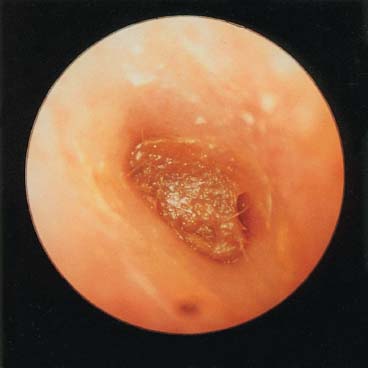
Figure 16–1 Cerumen.
Foreign Bodies
Foreign bodies in the EAC are another frequently encountered problem (Figs. 16–2 through 16–4). Common objects include beads, crayons, rocks, food matter, and insects. Small alkali batteries can cause chemical burns, and removal should be performed as soon as possible, followed by topical treatment with antibiotic/steroid drops.7 Other small objects such are rocks can frequently be removed in the office under binocular vision. A right-angle hook can often be positioned medial to the object and used to pull it laterally, facilitating removal. Small beads and other spherical objects can sometimes be removed with suction. Local ear canal injection with lidocaine can allow office removal of impacted objects.
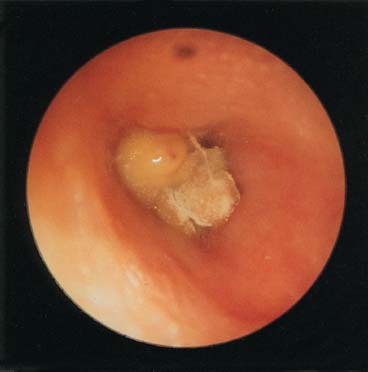
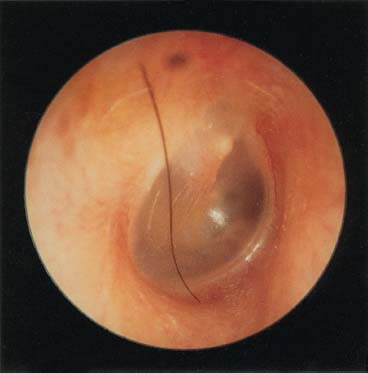
Figure 16–3 Hair.
Young children with foreign bodies in their ears can sometimes be restrained. However, in the uncooperative child, a general anesthetic might be necessary. Food matter like popcorn or beans may also be encountered, and irrigation should be avoided because of the propensity for these foods to swell. Insects (Fig. 16–5) enter the ear canal at night while the patient is sleeping, but because of their inability for retrograde mobility, and not enough room to turn around, they cannot exit the canal. Patients will often complain of an itching or tickling sensation in the ear and “hear” something in the affected ear if the insect is still alive. In such cases, an insecticidal liquid (alcohol or lidocaine) can be placed in the ear canal for several minutes.8 Once the insect has died, it can then be removed safely. Except for batteries, which require prompt removal, foreign bodies in the ear canal can usually be removed safely within several days of onset.
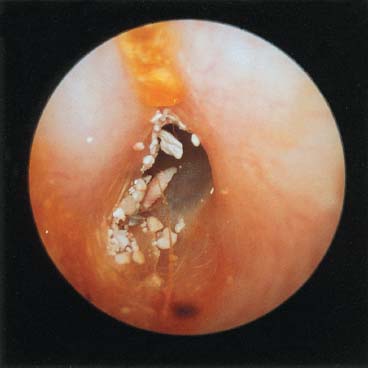
Figure 16–4 Pebble.
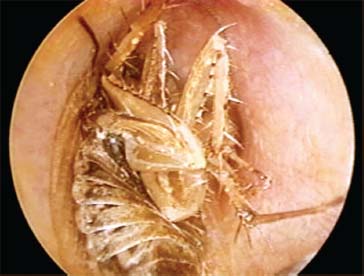
Figure 16–5 Insect.
Exostosis and Osteomas
Exostoses are bony outgrowths of the EAC (Fig. 16–6). They are frequently multiple and bilateral, and are associated with swimming and water sports. However, their exact pathophysiology is not completely understood.9,10 Van Gilse11 proposed that exposure to cold water for long periods of time produces erythema of the canal and a periosteal reaction that induces exostosis formation. More recent research shows that these lesions are not unique to humans, and are found in other mammals that spend considerable amounts of time in the water.12 These benign growths usually do not involve the suture lines and consist of broad-based lamellar bone.13 Usually these lesions are asymptomatic, but with excessive growth they can impair water and cerumen drainage from the EAC, resulting in otitis externa and hearing loss. The vast majority of these lesions are asymptomatic and require no treatment. Patients with recurring cerumen impactions medial to the exostoses might require frequent office debridement or use of softening agents such as mineral oil. Patients with obstructing exostoses and conductive hearing losses might benefit from surgical correction via canalplasty. This is generally performed through an endaural or postauricular approach. It is important to preserve as much canal skin as possible to prevent potential EAC stenosis. As these lesions are broad-based, removal is best performed using high-speed cutting and diamond burs. Small canal skin defects can be covered with a fascia graft and allowed to heal, in which case the graft acts as a scaffold and the epithelium migrates across during the healing process. Larger defects might require a small skin graft, which can usually be obtained from the postauricular area. Recurrent disease is not uncommon.14
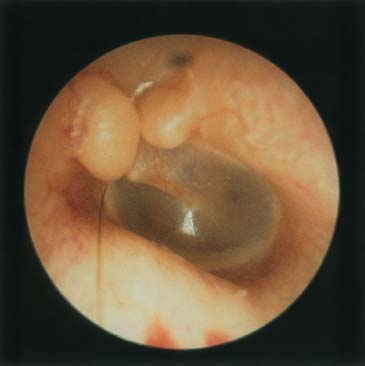
Figure 16–6 Exostosis.
Osteomas are bony lesions that are usually unilateral, and almost always found attached to the tympanosquamous or tympanomastoid suture (Fig. 16–7). These lesions differ from exostosis in that they are less common and solitary.13 The typical location also differs in that these lesions are usually more laterally based. These neoplasms are less likely to be symptomatic, but when they obstruct the canal or impede cerumen migration, they should be removed, usually through an endaural or postauricular approach.
Keratosis Obturans and Canal Cholesteatoma
These two diseases initially were considered to be the same entity, but insight generated by Piepergerdes et al15 helped to elucidate key differences. Keratosis obturans usually is circumferential in its bony destruction, affects a younger age group, and usually is bilateral. It also has an affiliation for younger patients with bronchiectasis and chronic sinusitis. Its exact etiology is unknown, but it is thought to result from abnormal epithelial kinetics and loss of the lateral migration pattern of the squamous epithelium. Canal cholesteatoma is different in that it usually affects an older age group, is unilateral, and frequently is associated with a dull-aching, chronically draining ear.16 These lesions are not circumferential in their destruction pattern. They typically result from trauma to the EAC, either postsurgical or self-inflicted. Nontraumatic EAC cholesteatomas are a much rarer entity.
The treatment of keratosis obturans is conservative. These patients generally require serial office debridements under the microscope. Topical therapy with antibiotic or steroid drops is reserved for disease that has a corresponding inflammatory or infectious component. Surgical therapy is generally not indicated.
Canal cholesteatomas usually can initially be managed conservatively, especially in the elderly or debilitated patient.17 Such patients are typically seen on a regular basis for office debridement. A softening agent, such as mineral oil can be used by the patient several days prior to the visit to facilitate cleaning under the microscope. In younger patients or in those with progressive, symptomatic disease, surgical intervention may be necessary. This usually requires an endaural or postauricular approach. Normal-appearing ear canal skin should be preserved. The TM and ossicular chain are usually not involved with EAC cholesteatomas, and should be preserved. Next a canalplasty is performed, with removal of disease until healthy appearing bone is identified. Small canal skin defects can be covered with a fascia graft, whereas larger defects might require a small skin graft from the postauricular area.
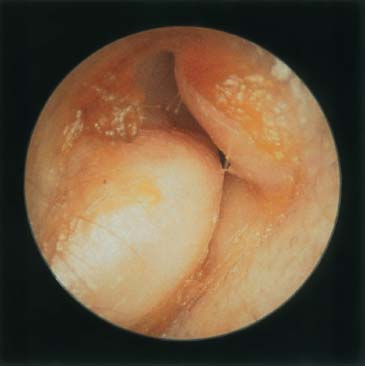
Figure 16–7 Osteomas.
Inflammatory Polyp
Inflammatory polyps of the middle ear can present as masses in the EAC (Fig. 16–8). These lesions typically are seen with chronic otitis media with or without cholesteatoma. Other causes include foreign bodies in the EAC or TM, such as retained pressure-equalizing tubes; canal cholesteatoma; osteoradionecrosis; necrotizing otitis externa; benign tumors such as ceruminomas, cystadenomas, pleomorphic adenomas; and malignant tumors, such as squamous cell carcinoma. Most benign inflammatory polyps are not painful, and will respond to office debridement and topical therapy with steroid-antibiotic drops. Polyps that persist despite conservative treatment for several weeks indicate an underlying disease process. The most common causes are chronic otitis media and cholesteatoma. Perforations and retractions of the tympanic membrane are usually seen. Temporal bone computed tomography (CT) can help determine the extent of disease. Pain is always worrisome, and is common with necrotizing otitis externa and squamous cell carcinoma. Suspicious lesions should be biopsied. A negative biopsy may indicate no cancer or a nonrepresentative sample. It may be necessary to perform deeper biopsies under local or even general anesthesia to make sure they are representative of the disease process. All polyps should be treated until resolved.
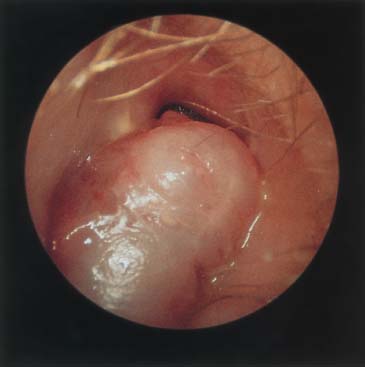
Figure 16–8 Large obstructing polyp.
Ear Canal Infections
Otitis Externa
Bacterial otitis externa is a common problem for the otologist as well as the general practitioner (Fig. 16–9). Infections can range from a brief problem in an immunocompetent individual to a devastating life-threatening infection in the immunocompromised individual. Individuals who are at risk for necrotizing otitis externa are discussed below.
Acute otitis externa is a common problem in swimmers. Swimming in contaminated water (lakes and rivers) increases the risk of pseudomonas otitis externa.18 The increase in moisture in the EAC causes edema and a more favorable environment for bacterial overgrowth. Cerumen has an acidic pH, and helps prevent bacterial growth in the EAC. A lack of cerumen and exposure to moisture predisposes to infection. Cleaning with cotton applicators can traumatize the thin epithelial lining of the bony EAC, which then predisposes to infection. Patients who wear hearing aids also are at increased risk of otitis externa because of the moist environment that is created in the ear canal and because of occasional EAC trauma. All of the above factors can create an environment that is optimal for bacterial growth, particularly pseudomonas and to a lesser degree staphylococcal species.19
Stay updated, free articles. Join our Telegram channel

Full access? Get Clinical Tree


